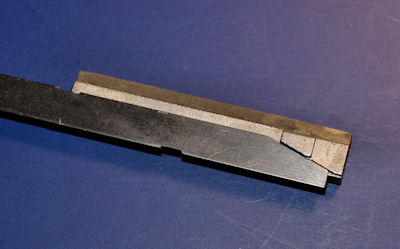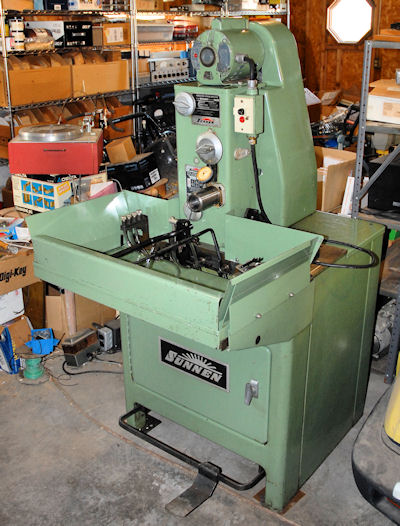
There are various ways to size and finish a bore- drilling, reaming, boring, circular interpolating, laser cutting, waterjet, lapping, ball finishing, roller burnishing and no doubt various others. One of the best is honing. There was a time when just about every place had a shop that specialized in rebuilding engines. Almost all of them had a Sunnen honing machine for reworking and sizing rods, pistons and various other bushings, like kingpins. Kingpins were important at one time, though today I think you'll only find them on heavy equipment.
Well equipped machine shops often had a honing machine too, though fewer do today. These days, CNC machining is so good that honing is a distant memory in most shops. They probably don't miss the oily mess, and the process takes a bit of skill and practice to master- it's not for button pushers who don't like to get their hands dirty. The fact is though, when you need a hone, nothing else will do. Nothing else will be as fast and nothing else will be as controllable and precise.
Honing can bring an already good bore into almost perfect roundness and straightness, plus size it within close tolerance. In a job long ago I used to hone small parts to 15 millionths of an inch with little trouble. Air gauging was the measurement method of choice. The surface finish can range from a medium cross-hatch to a near mirror polish, depending on the stones and technique. Almost any material can be honed, given the right tooling. The value of honing can be seen when one begins honing what appears to be a very good reamed bore. The lobes and imperfections produced by almost all reamers immediately show up as the hone starts removing the high spots. The effect is even more dramatic on holes produced by circular interpolation.
The machine appears simple, a spinning mandrel that carries an abrasive stone in a slot, but a few subtle details make it capable of extraordinary accuracy. The stone is raised up from the mandrel by a shallow wedge. Because the wedge is shallow, the machine can easily raise the stone, but pressure from the work can't force it back down. That means any high spots in the work receive all the pressure and are quickly ground down. The machine applies pressure to the wedge through an adjustable spring, so the stone is automatically raised up as the diameter of the bore increases. Naturally the geometry of the mandrel and stone has to be perfect. This is achieved by running the mandrel and stone in a sacrificial piece called a truing sleeve, with the honing oil shut off. A lapping paste quickly builds up, wearing the mandrel and stone into perfect cylindricity. When the oil is turned back on, the wear on the mandrel and stone reduces to a much lower amount, with all the correcting action taking place on the part.
Here's a complete Sunnen honing mandrel alongside the wedge and stone it contains. The mating faces of the wedge and stone are shown.

This photo shows the wedge and stone in their normal relationship. One wedge is hidden but you can see how the stone will slide up parallel to the wedge as the wedge is forced forward.

It took me a while to find the right machine at the right price, but I now have a Sunnen MBB-1660 machine in my garage shop that I've refurbished to near new condition. I've also modified the oil system to use far less than the normal amount of oil, as described below.

The MBB-1660 holds 15 gallons of expensive honing oil. It actually needs about 10 gallons to function properly. No doubt when doing production quantities of parts, something the machine was specifically designed for, it makes sense to use the full oil capacity. There's a settling tray where grit and metal particles are removed from the oil before it drains back to the main reservoir, so the oil system is somewhat self-cleaning.
I do small numbers of physically small parts, so the oil system far exceeds my needs. The capacity can be reduced somewhat by placing large pieces of metal in the reservoir, but this isn't a very efficient way to do it. My solution was to buy a $2 dish pan at Wal-Mart and place it under the pump. The tray outlet is a male pipe fitting, and the drain pipe pivots on a mating elbow. I simply removed the pipe and elbow, replacing them with a female-female coupler and a hose barb. A new piece of hose runs from the hose barb to the dish pan. You lose the function of the settling tray, but the machine will now run on 1-2 gallons of oil. I'll report back on how well this works out at a later date.
The downside of honing is that each mandrel covers a limited range of sizes, and several different types of stones may be required for best results. Stones come in aluminum oxide, silicon carbide, borazon and diamond. They cover a range of grits and hardnesses so the number of combinations is overwhelming. Fortunately just a few cover about 90% of all applications. Each mandrel also requires an adapter and a truing sleeve. If one has to tool up for a new size, everything needed can be $200-$300. Sometimes suitable surplus tooling can be found on eBay or other machine tool auction sites, but it's a matter of timing and luck. Even then, a complete mandrel might be $50 or more. Alas, many of the mandrels found on eBay are worn out and ready for the trash heap, but the sellers may not know enough to judge the condition. Or they do but just want to move 'em for as much as they can get. Always examine the shoes (the wearing surfaces) for a healthy groove in the middle. If the groove is nearly gone, so is the mandrel. The larger mandrels may have replaceable shoes, so wear is much less of a problem. Wedges can wear too, but those are inexpensive.
So far, my regular tooling covers many common fractions from about 1/4" to 1 1/8" and hopefully, over time, I'll be able to fill in at least the common sizes. Special tooling is needed for very long parts, parts with keyways and certain materials that are only compatible with bronze shoes. There are special mandrels for blind holes and tandem holes. Though new machines have become quite expensive, the honing companies have always followed the razor and blade business model- If they can get you to buy a machine (the razor), they know you'll be buying expensive tooling (the blades) every time a new job comes up.
Admittedly, a honing machine is pretty uncommon for a hobbyist shop, but as I said at the beginning, when you need a honing machine, nothing else will do.